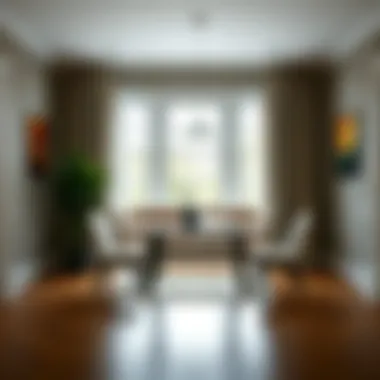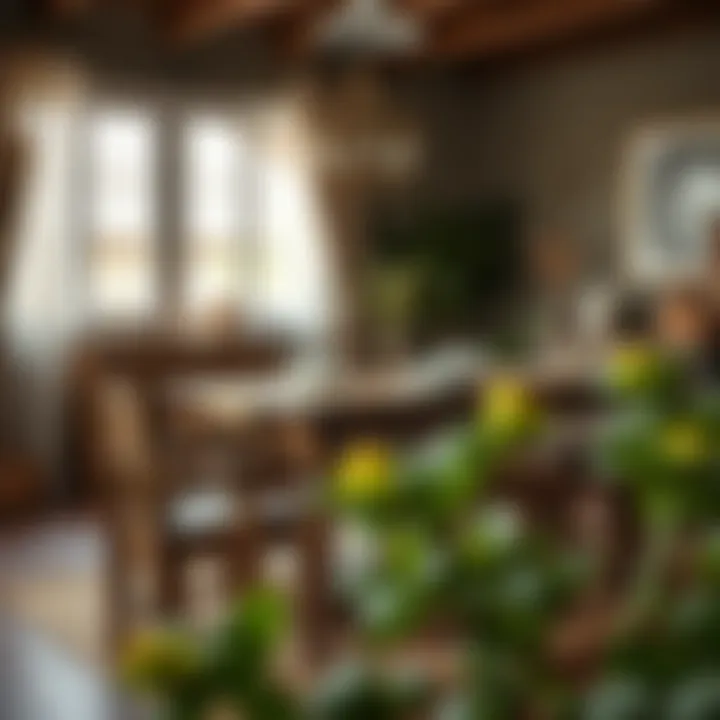Dining Room Benches with Backs: A Comprehensive Guide


Intro
Dining rooms represent the heart of a home, a space where family and friends gather to share meals and create cherished memories. As such, the furniture we choose for these areas must strike a delicate balance between aesthetics and functionality. Dining room benches with backs have emerged as a favored choice among homeowners and designers alike. These versatile pieces blend comfort and style, making them suitable for a variety of dining room decors.
In this exploration, we will dissect key elements related to selecting and appreciating dining room benches with backs, honing in on trends, materials, styles, and practical tips for making choices that resonate with both personal taste and the overall design vision of a home.
Furniture Design Trends
Trending Materials and Textures
In recent years, the materials used in dining room benches have evolved significantly. Traditional wood is still revered for its classic appeal, but modern designs are now incorporating a mix of materials such as metal, upholstery, and even woven elements.
- Wood: Oak, walnut, and reclaimed wood are popular, offering durability and a touch of rustic warmth.
- Metal: Sleek, industrial designs often feature metal frames that lend a contemporary edge, ideally complementing minimalist or urban spaces.
- Upholstery: Fabrics like velvet or linen can make a bench cozy, encouraging long, leisurely meals.
Textures play a pivotal role in creating visual interest. Mixing materials can help achieve a layered look. For instance, a wooden bench with a soft, upholstered back can offer comfort while retaining a contemporary aesthetic.
Color Palettes and Styles
When it comes to color, trends ebb and flow, but certain shades seem to get more attention in dining room bench design. Neutral tones such as beige or grey continue to dominate, acting as versatile canvases.
However, a bold splash of color can breathe life into the space. Here are some popular choices:
- Earthy Tones: Warm greens, burnt oranges, and terracotta tones bring a grounded sense of comfort.
- Bold Hues: Deep navy or rich burgundy can add sophistication and serve as focal points in the room.
In terms of style, benches are no longer limited to just traditional or modern designs. Trendy hybrid styles, where traditional shapes meet modern finishes, have gained traction.
"The right piece can transform an ordinary dining room into a stylish retreat, making every meal an event to remember."
Practical Tips for Furniture Selection
Assessing Space and Functionality
Before committing to a dining room bench, it's crucial to assess the space. A well-planned layout optimizes the flow of the room and enhances the dining experience. Consider these factors:
- Dimensions: Measure the space available. A bench that’s too large can overwhelm, while one that’s too small may not provide adequate seating.
- Layout: Think about how the bench will integrate with the dining table. Ensure there’s enough room for diners to sit comfortably.
Balancing Aesthetics with Comfort
The aesthetic appeal of a dining room bench needs to harmonize with comfort. Look for benches with supportive backs and, if possible, cushioned seats. Consider these aspects when making your choice:
- Comfort Level: Test out the seating—does it feel inviting?
- Style Consistency: Ensure that the bench complements the overall décor, whether that’s rustic farmhouse, chic country, or urban modern.
Assessing both style and comfort will not only enhance the look of your dining room but also encourage it to be a space where memories are made, fostering long discussions and shared laughter.
Preface to Dining Room Benches with Backs
Dining room benches with backs are becoming an increasingly popular choice in home design, offering a blend of comfort, style, and practicality often found lacking in traditional dining chairs. These benches serve not only as functional pieces of furniture but also contribute to the overall aesthetic of a dining area, making them worthy of consideration for anyone looking to enhance their eating space.
One of the most significant elements when exploring dining benches with backs is their ability to maximize seating capacity while allowing for a relaxed atmosphere. In a world where space often comes at a premium, benches with backs provide ample seating options without overwhelming a room. This makes them particularly beneficial for larger family gatherings or social events where every seat counts.
Moreover, the backrest of these benches adds an element of comfort that transforms mealtimes into enjoyable experiences. Unlike basic benches without back support, those equipped with backs encourage longer, more leisurely dinners, promoting conversation and connection among family and friends.
Understanding the Concept
To grasp the relevance of dining room benches with backs, one must first comprehend their design and functionality. These benches not only serve as a seating solution but also enable a flexible arrangement that can be adapted to various layouts, from linear to U-shaped. This adaptability is particularly appealing for homeowners and designers looking to create dynamic dining spaces.
When selecting a dining bench with a back, one should consider elements such as height, depth, and style. The height should complement the dining table, ensuring comfort during meals, while the depth dictates how much space each person will occupy. Additionally, the style can range from contemporary upholstery to rustic wooden designs, thereby allowing for greater personalization in dining aesthetics.
Historical Evolution of Dining Benches
The history of dining benches is rich and varied, reflective of cultural shifts and preferences throughout the ages. Originally, dining benches can be traced back to ancient civilizations, such as the Greeks and Romans, who utilized long wooden benches in communal eating spaces. These designs emphasized togetherness and shared experiences, laying the groundwork for the modern dining bench.
As we moved toward medieval times, the introduction of backs on benches altered their functionality. The addition of backrests allowed for a more comfortable dining experience, which in turn made it more appealing for families and guests to gather around the table for longer durations.
Fast forward to the industrial revolution, where mass production ushered in new materials and designs. The varied styles that emerged during this period incorporated both artistic elements and practical orientations, resulting in the broad range of seating options we have today. From sleek modern lines to ornate traditional carvings, the evolution of dining benches showcases not only the changing tastes of furniture design but also the ongoing importance families place on shared dining experiences.
In summary, understanding dining room benches with backs presents a compelling case for their inclusion in modern homes. The perfect blend of utility and artistry enhances the dining area, fostering connections while offering comfort. As designs continue to evolve, the future appears bright for those seeking inviting and tasteful dining environments.
Types of Dining Room Benches with Backs
When it comes to enhancing the functionality and style of a dining area, the selection of benches with backs becomes pivotal. These benches offer an inviting seating arrangement that balances comfort and aesthetics, adapting to various decor styles and family needs. Each type of bench carries a distinct character, contributing to the overall atmosphere while catering to practical requirements. In this section, we will delve into different styles of dining room benches with backs, offering insights that will help homeowners transform their dining spaces effectively.
Traditional Design Bench Options
Traditional design benches evoke a sense of nostalgia, often resonating with classic shapes and materials. Usually made from hardwood, these benches tend to incorporate intricate carvings that speak to their craftsmanship. They often feature elements such as turned legs, ornate backs, and can even be finished with rich stains to highlight the grain.
Some popular options in this category include:
- Farmhouse Benches: These are sturdy and practical, lending a rustic charm that complements country-style kitchens or dining rooms.
- English Settles: These benches are particularly noteworthy with their high backs and wide seat area, offering luxurious comfort during family meals.


The warmth and character of traditional design benches can create an inviting atmosphere, perfect for both casual get-togethers and formal occasions.
Modern Minimalist Benches
Moving into more contemporary spaces, minimalist benches strike an appealing balance between form and function. These designs typically feature sleek lines, a low-profile structure, and often incorporate neutral colors like white, grey, and black. With an emphasis on simplicity, modern benches are functional and become a striking focal point in the dining room.
Key characteristics include:
- Streamlined Shapes: The absence of excessive ornamentation helps maintain a clean aesthetic.
- Multi-functional Uses: Many modern designs serve well in various roles, whether as extra seating or a statement piece that enhances the overall decor.
These benches are ideal for those who lean towards a more understated environment, providing comfort without overwhelming the space.
Rustic and Farmhouse Styles
Rustic and farmhouse style benches are a feast for the eyes, oozing charm and character. They often utilize reclaimed wood or materials like distressed finishes that tell a story of their own. This type of bench connects the past and present, making it an essential feature for anyone seeking a cozy vibe.
Consider these popular elements:
- Distressed Finishes: A well-worn appearance gives a bench its rustic flair, evoking a sense of history and tradition.
- Natural Elements: Many rustic benches include raw edges and organic shapes, inviting the natural world into the home.
The farmhouse aesthetic promotes a warm and welcoming dining environment, enhancing connections between family and friends.
Contemporary Upholstered Benches
Upholstered benches bring another comfort layer to dining experiences. They generally feature soft seating, making them perfect for long dinners or special occasions where people linger over good food and conversation. Upholstery allows for incredible versatility in terms of style and color, enabling a seamless blend with various decor themes.
Highlights of upholstered benches are:
- Fabric Variety: The choice of fabrics can range from luxurious velvet to durable canvas, providing options to suit different tastes and durability needs.
- Comfort Features: This type of bench often incorporates additional padding, enhancing the overall sitting experience.
A contemporary upholstered bench can inject a pop of color into the dining room, transforming it into an inviting space.
Industrial and Metal Bench Options
For those drawn toward an edgy or urban aesthetic, industrial and metal benches can redefine a dining space. Usually constructed from robust materials such as steel or iron, these benches offer durability and a bold presence.
Noteworthy features include:
- Combination of Materials: Metal frames paired with wooden tops create a striking contrast, providing visual interest.
- Functional Design: These benches are often designed to maximize space efficiency, making them suitable for both large and compact dining areas.
Industrial benches can add an unexpected twist to a more traditional dining setting, making them an excellent choice for individuals looking to challenge conventional design norms.
By understanding these various types of dining room benches with backs, homeowners can select options that best fit their style and functional needs, creating dining spaces that are as inviting as they are stylish.
Materials Used in Dining Benches
Choosing the right materials for dining benches is crucial because it directly influences durability, comfort, and aesthetic value. The materials you select can define the overall vibe of your dining space, making it either warm and inviting or sleek and modern. This section will discuss various materials typically used in dining benches, highlighting their properties, advantages, and challenges to give you a well-rounded perspective.
Wood Choices and Their Properties
When you think of dining benches, wood is often the first material that springs to mind. It's timeless and encompasses a broad range of species, each with unique characteristics. For instance, oak is a robust option, celebrated for its durability and beautiful grain patterns. It tends to hold up well against wear and tear, making it ideal for bustling households.
In contrast, pine is lighter and typically more affordable. Its softer texture means it may not withstand heavy use as well as denser varieties, but it can be perfect for casual settings. Here's a quick look at popular wood choices:
- Maple: Known for its fine, smooth grain and resistance to staining, it's a solid choice for families.
- Walnut: This wood radiates elegance with its rich, dark tones, making it suitable for more sophisticated dining spaces.
- Teak: Especially notable in outdoor settings, teak has natural oils that resist moisture, thus preventing decay and deterioration over time.
Finding the right type of wood often comes down to balancing aesthetic preferences with practical needs. Consider how the wood complements other elements in your dining area; the right finish can either unify the decor or serve as a statement piece.
Metal Components and Durability
Metal dining benches add a modern twist to traditional designs. Materials like stainless steel, aluminum, and iron are not only stylish but come with distinct durability benefits. Stainless steel is resistant to rust and corrosion, making it suitable for both indoor and outdoor use. This durability is very important in environments exposed to the elements.
On the other hand, aluminum is lightweight and can come in various finishes or colors. It's less durable than stainless steel but brings flexibility in design. Iron, often used in decorative bases or frames, provides a solid structural integrity but may require periodic maintenance to prevent rust, particularly in damp areas.
Metal components can contribute to a sleek, industrial feel in your dining room. However, they may also produce a less cozy atmosphere if used excessively. Proper integration is key; balancing metal with softer materials like wood or upholstery can create a well-rounded look.
Upholstery Options: Fabric vs. Leather
Upholstered benches open up a new realm of possibilities. When selecting upholstery, homeowners typically weigh the benefits of fabric against leather. Fabric options can range from cotton and linen to synthetic textiles, and they offer an extensive variety of colors and patterns. They provide comfort and a homey feel, while also being more forgiving regarding cost.
Leather, while usually more expensive, exudes elegance and can withstand rigorous use when well cared for. It is resistant to stains and can last for many years if maintained properly. Nevertheless, leather can be less breathable, which may not be ideal for warmer climates. Here's a comparison of both choices:
- Fabric:
- Leather:
- Pros: Variety of colors and patterns, more affordable.
- Cons: May require more cleaning and maintenance.
- Pros: Durable and elegant, easier to clean in terms of spills.
- Cons: Generally pricier, can be less comfortable in heat.
Ultimately, the choice between fabric and leather comes down to lifestyle needs, personal taste, and budget. Think about how often the bench will be used, especially in homes with children or pets.


Eco-Friendly Materials and Sustainability
In a world increasingly conscious of environmental impacts, selecting sustainable materials is more than a trend; it’s becoming a necessity. Many manufacturers are exploring eco-friendly options. Bench materials made from reclaimed wood or sustainably sourced timber minimize environmental damage and add a unique character to each piece.
Bamboo is also gaining popularity as a sustainable alternative. It grows quickly and requires less resource intensity than traditional hardwoods, giving a sense of tranquility and nature to your dining space. Moreover, recycled metal options are popping up, designed to cater to eco-minded consumers while ensuring durability and modern aesthetic.
"Choosing eco-friendly materials can significantly reduce the carbon footprint of your home."
When choosing materials for dining room benches, be mindful of how they align with your values and lifestyle. Each material you explore opens up a dialogue about personal style and responsibility.
Functional Benefits of Benches with Backs in Dining Spaces
Dining room benches with backs offer a kind of value that extends far beyond simple seating arrangements. These functional pieces serve essential roles in dining spaces, providing comfort, flexibility, and an inviting atmosphere for both family and guests. Understanding the practical benefits can significantly influence choices for anyone looking to furnish their dining area.
Maximizing Seating without Sacrificing Comfort
One of the standout features of benches with backs is their capacity to optimize seating arrangements. Unlike traditional chairs, which may cramp together at the table, benches often allow for more guests to fit comfortably. A well-designed bench can seat three or four people, creating a cozy atmosphere without the feel of being overly crowded.
Comfort is key when it comes to dining experiences. Benches equipped with ergonomic backs provide necessary support, allowing diners to sit for extended periods without discomfort. When you’re hosting a dinner party or enjoying family meals, this added comfort can greatly enhance the overall experience. Guests feel more at ease, encouraging longer conversations and deeper connections. The careful balance between space and comfort makes such benches an excellent investment.
Versatility in Space Utilization
Another significant advantage of benches with backs lies in their versatility. They can seamlessly transition between formal and casual settings, adapting to the needs of various dining configurations. For instance, a bench can fit snugly against a wall in an intimate breakfast nook or serve as a centerpiece in a long banquet-style setup.
Moreover, their functional design means they can double as practical storage solutions. Some benches come with hidden compartments, allowing you to stow away table linens or seasonal items, reducing clutter in the dining area.
- Benefits of Versatility:
- Suited for different dining styles
- Space-saving designs
- Multi-functional uses (seating and storage)
Enhancing Family Interaction and Engagement
Benches with backs foster an environment of warmth and togetherness. When families gather around the dining table, the communal feel that these benches create encourages interaction. Unlike chairs that can separate diners from each other, benches tend to promote a more inclusive atmosphere.
They often invite everyone to sit closer together, facilitating easier conversation flow. For families with young children, having them seated on a bench can also help in creating an easier mealtime dynamic, as parents can sit nearby, helping with every little need while still enjoying their meal.
"A cozy dining space enriches not just meals but memories we cherish for a lifetime."
When selecting a bench, consider the design and style that resonate with your family values and lifestyle needs. Whether it mirrors a modern aesthetic or has a rustic flair, the right choice enhances not only the dining room's function but also its emotional warmth.
Aesthetic Considerations in Choosing a Bench
When selecting a dining room bench, aesthetics play a pivotal role in shaping not just the look of the space, but also the entire atmosphere. A dining area should reflect the personality and style of its inhabitants, and the right bench can serve as the focal point around which design elements coalesce. From complementing existing furniture to standing alone as a piece of art, the choices made here resonate deeply in terms of ambiance and comfort.
Aligning Style with Interior Design
Choosing a bench that aligns with the overall style of your interior design is like picking the perfect piece in a puzzle. You want it to fit snugly into your design scheme without clashing or appearing out of place.
- Understanding Styles: Traditional, modern, minimalist, or rustic—there are numerous styles to consider. For instance, a farmhouse-style bench, crafted from reclaimed wood, adds warmth and character to a cozy dining area, while a sleek, streamlined metal bench conveys a contemporary vibe.
- Textural Harmony: The texture of the bench plays a crucial role too. A smooth, metal bench might look odd when placed beside a rough-hewn wooden table, while a fabric-upholstered option might soften the hard lines of a glass-topped table.
- Size Matters: Scale is of the essence. A bulky bench in a petite room could dwarf the space, whereas a slender bench might get lost in a large dining area. It’s important to visualize the proportion of your chosen bench against the dining table and other elements in the room.
Combining these factors ensures that your choice of bench not only meets functional requirements but also strengthens the aesthetic narrative of your dining area.
Color Coordination and Visual Balance
Color is a fundamental aspect of design that can influence mood and perception. It’s not merely about choosing what looks good; it’s about achieving a harmonious balance that connects all elements of a space. Here’s how to navigate this aesthetic landscape:
- Complementary Hues: When selecting a bench, consider colors that either complement or contrast effectively with your walls, table, and decor. A bold, deep blue bench can stand out against a neutral palette, creating a striking focal point, whereas softer shades might blend seamlessly, promoting a calm ambiance.
- Accent Colors: Utilizing the color wheel can aid in identifying accent colors that resonate with your space. If your dining area features warm tones like browns and yellows, a bench with warm upholstery can tie everything together nicely.
- Material Influence: The material of the bench can also impact how colors are perceived. A fabric bench may reflect light differently than leather or wood, leading to variations in how colors are seen under different lighting conditions.
In practice, maintaining visual balance can be achieved through:
- Repetition of Colors: Carrying a color from one element to another—like a throw pillow on your bench that matches a piece of art on your wall.
- Contrast for Interest: On the other side, introducing contrasting shades can create visual interest. That might mean placing a light bench against dark walls or using an accent cushion that pops against a muted backdrop.
- Natural Light Considerations: The changing light throughout the day will also affect color perception. A bench that looks vibrant in morning light may seem muted in the evening, so it's wise to test your selections in different lighting conditions.
"The beauty of design lies in its details; getting the color and style of your bench right can uplift the entire dining experience."
Practicality and Maintenance of Dining Room Benches
When it comes to dining room benches with backs, considering their practicality and maintenance is essential in making an informed choice. The right bench not only serves your aesthetic preferences but also needs to align with your lifestyle and usability requirements. Functionality should never take a back seat (pun intended!) in your selection process. Oftentimes, homeowners focus on style but forget that maintenance plays a big role in longevity and everyday usability.
Cleaning and Care for Different Materials
The materials used in making a dining room bench determine how easily you can clean and maintain it. For instance:
- Wood: While wooden benches have a classic appeal, they require specific cleaning methods to prevent damage. A soft cloth dampened with water and a gentle wood cleaner is often sufficient. It's advisable to avoid excessive moisture as it can warp the wood over time.
- Upholstery: Fabric-covered benches can easily attract stains, especially in homes with children or pets. Regular vacuuming is essential, coupled with immediate attention to spills. Utilizing a fabric protector can help maintain appearance, but it’s crucial to check the manufacturer's cleaning instructions.
- Leather: Leather benches offer a luxe touch but require their own care regimen. Regular dusting and the occasional application of leather conditioner keeps them looking fresh. However, avoid harsh cleaners that could strip the leather's natural oils.
- Metal: Metal benches tend to be the easiest to clean. A simple wipe with a mild detergent and soft cloth can remove most grime. Ensure to check for rust, especially if used in humid conditions, applying a rust inhibitor if necessary.
Overall, understanding the cleaning requirements of your chosen materials helps set realistic expectations for maintenance.
Durability Factors to Consider
When selecting dining room benches, assessing durability is key. After all, these pieces should withstand daily use and still retain their charm. There are a few factors to keep in mind:


- Construction Quality: A well-built bench, whether made from solid wood or metal, is generally more durable. Inspect joints; a bench with dovetail joints or mortise and tenon joints indicates craftsmanship.
- Weight Capacity: Make sure the bench can comfortably support the weight of all potential users. Look for specifications on weight limits when purchasing.
- Finish and Coating: The type of finish used on wood or the coating used on metal can drastically affect the longevity of your furniture. High-quality finishes resist scratches and dents better and offer protection from elements.
- Usage Patterns: Consider how often you’ll use the bench and in what context. A bench that sees daily family dinners will face different wear and tear compared to one used sparingly.
"Selecting a dining room bench is about finding the balance between style and practicality; don't let one overshadow the other."
For more detailed insights on furniture care, visit GovInfo and Design Community.
Ultimately, a well-maintained bench enhances not only your dining experience but also adds value to your space.
Incorporating Benches into Various Dining Room Configurations
When considering furniture for dining spaces, benches with backs can transform the entire layout and functionality of the area. Not only are they a unique addition, but they also offer flexibility that traditional dining chairs might not provide. This section delves into how different dining room configurations can benefit from incorporating benches, discussing various setups and their specific advantages.
Long Tables and Banquet Style Setups
In large dining areas, especially those designed for entertaining, long tables are quite common. Utilizing benches with backs around these tables can enhance the overall experience. They can accommodate more guests, allowing for spaces that both invite conversation and maintain comfort. The back support offered by these benches encourages longer meals, often extending into laughter and stories shared. Additionally, in banquet style settings, the visual appeal of matching benches can create a cohesive look.
"Having a swath of backs lined up against the table practically invites everyone to stay a while longer, fostering a family-style gathering feeling."
Consider the following advantages of using benches with backs in long table setups:
- Increased Comfort: With multiple cushions and back support, diners can enjoy prolonged seating.
- Enhanced Aesthetics: Uniformity in the bench design can elevate the room's style, harmonizing the decor.
- Versatility: If a large group doesn't show up, these benches can be easily repositioned or used in other areas.
Square and Round Table Configurations
In contrast to long tables, square and round tables offer a more intimate setting for smaller gatherings. Here, benches with backs serve a dual purpose. On one hand, they make it easier to maximize seating capacity, especially when dealing with unconventional table shapes. On the other hand, they help in blending form with functionality in a way that a traditional chair might not. The rounded edges of the table can guide the arrangement of benches, creating a flow that is pleasing both for visuals and interaction.
When incorporating benches into these configurations, think about these factors:
- Spacing: Ensuring there's enough legroom without feeling cramped promotes comfort for diners.
- Proximity: Benches naturally bring people closer, encouraging conversations amid shared meals.
- Design Alignment: The bench style should complement the table shape to create a balanced environment.
Open Concept Dining Areas and Space Planning
Open concept designs have been gaining traction in modern homes. Here, dining areas often blend with living spaces, creating a need for smart furniture choices. The benches with backs can seamlessly unify the two areas. They act as a partition while also providing seating that doesn’t feel invasive.
Incorporating benches in open concept designs features key considerations, such as:
- Zoning: Benches can help define the dining area within an expansive space.
- Flow of Movement: Smooth transitions between areas promote a welcoming atmosphere for guests.
- Dual Functionality: Benches often come with storage options, allowing for multi-purpose use, making the most out of limited square footage.
By thoughtfully integrating benches into various dining configurations, homeowners can shape a dining area that is not only functional but also visually appealing, steering clear of traditional setups and exploring new possibilities.
Future Trends in Dining Room Bench Design
As we look toward the horizon, the future of dining room bench design reflects not just aesthetic preferences but also evolving lifestyles and needs. This section emphasizes the significance of staying ahead in design trends, ensuring that benches not only please the eye but also offer unparalleled functional benefits. With an increasing focus on sustainability, comfort, and adaptability, it’s crucial to understand how these trends will shape our dining spaces in the years to come.
Innovations in Materials and Construction
In recent years, there has been a noticeable shift towards innovative materials and construction techniques that enhance both the durability and appeal of dining room benches. The shift is driven by people increasingly seeking sustainable yet stylish options. Here are some notable trends:
- Recycled Materials: The use of recycled wood and metal is on the rise, pushing boundaries while also lowering the carbon footprint. This not only helps the environment but also introduces unique textures and patterns.
- Smart Technology Integration: Embedding technology, such as built-in charging ports or smart upholstery that can change color or pattern with a simple app, is becoming more popular. This feature caters to the tech-savvy generation.
- Adaptive Designs: Modular benches are gaining traction, allowing homeowners to rearrange or resize their dining areas effortlessly. This versatility caters to gatherings of all sizes, whether it’s an intimate family dinner or a bustling brunch party.
"In the world of design, evolution springs from necessity; thus, those adapting to new materials and technologies will find remarkable benefits in both style and functionality."
Adapting to Changing Lifestyle Needs
As lifestyles shift, especially after recent global events emphasizing the importance of home environments, dining benches must adjust to these changes. Here’s how:
- Multipurpose Use: Modern benches are designed not just for dining. Many now serve as storage solutions or can be moved to other areas of the home, like entryways or living rooms. This evolution means that one piece can serve multiple purposes, making it a practical investment.
- Height and Comfort Adjustments: With more families working from home, the demand for comfortable seating that can accommodate both dining and remote work is on the rise. Benches are being crafted with varying heights and cushions that are suitable for extended use, balancing style with practical needs.
- Family-Oriented Designs: The emphasis on family connections has led to benches designed specifically for larger gatherings. Some come with built-in backrests that can be adjusted to foster conversation and interaction among everyone seated.
In this fast-paced world, staying in the know about trends keeps one’s home not only attractive but also aligned with contemporary life.
End: Making Informed Choices
In summing up the intricate tapestry woven throughout this exploration of dining room benches with backs, it becomes apparent that making informed choices is more than just a facet of decorating; it is a critical aspect of curating a space that resonates with your personal preferences and aligns with practical needs. A dining room bench is not merely a seat; it’s a statement piece, a functional element, and often the heart of dining experiences shared with friends and family.
When considering a bench for your dining area, it's essential to reflect on several key elements:
- Space Constraints: Up first, ensuring that the bench fits well within your room's dimensions is crucial. A bench that crams the space can quickly transform your dining haven into a cramped corridor.
- Comfort Levels: Comfort shouldn't take a backseat—pun intended. The height and cushioning of a bench can dramatically alter the dining experience. Warm memories are often built around comfortable seating.
- Material Choice: Selection of materials; hardwoods provide durability, while soft fabrics might add charm but require more maintenance. Each choice impacts not just aesthetics but longevity.
- Style Alignment: Whether leaning towards contemporary, rustic, or industrial vibes, aligning your bench's design with your existing decor can create a seamless, cohesive environment.
Taking the time to ponder these considerations helps in filtering through the choices available, leading you toward a bench that echoes your taste while fulfilling your needs. The paradox of choice can often muddy decision-making; however, focusing on your core requirements will simplify the search.
Reflecting on Preferences and Needs
It all begins with understanding your lifestyle and aesthetic preferences. Ask yourself key questions: Do you prefer traditional elegance, or does a minimalist design suit your vibe more? The answers to these inquiries guide you toward what truly feels right. Engaging with your family to explore preferences can also prove beneficial, allowing everyone to have their say, ensuring that the final choice enhances the shared dining experience.
Hands-on experiences—like visiting showrooms—can really bolster your perspective. Testing comfort by physically sitting on different styles provides insight that mere images cannot deliver. For many, benches allow for flexible seating arrangements. If you often host dinner parties, a bench can adapt to accommodate guests better than a collection of chairs might.
Creating Functional and Stylish Dining Spaces
Creating a balance between function and style can be quite the task, but it’s not impossible. A well-chosen dining room bench can act as a bridge between these elements. Start with color and texture—these play significant roles in setting the tone of your dining area. Cohesion within your decor not only adds to the visual appeal but creates an inviting atmosphere where meals become memorable.
- Balance and Harmony: Use color palettes that complement existing elements in the room. A wood bench may fit beautifully alongside a wooden table while a colorful upholstered piece could brighten up a more subdued setting.
- Functional Layouts: Consider bench placement. They can be effective in corners to save space while still providing ample seating.
- Seasonal Changes: Think about cushions or throws that reflect seasonal trends. This allows you to refresh your space effortlessly throughout the year.
"A well-chosen dining bench transcends mere utility and becomes a cherished component of family life and aesthetics."
In essence, harnessing this knowledge, you will be better equipped to make selections that truly enrich your dining experiences.



